Geobotany and Field Trips
Deep Woods Preserve, Hocking County, OH
This field trip was so much fun, trekking through the woods for a few hours and looking at plants, and learning so many interesting things! For this adventure, we journeyed east to Deep Woods Preserve in Hocking County, Ohio. A special thanks to the Blyth family for letting us wander and discover the wonderful flora of their privately-owned property. Here is some of the awesome information we learned on our expedition.
Substrate-Associated Plants
As you may recall, in my Geobotany page for Batelle Darby and Cedar Bog, I wrote about the cool plants that prefer that limy substrate of western Ohio based on Jane Fortsyth’s geobotany article. Well, here at Deep Woods–and much of eastern Ohio–hills of sandstone form the basis of this acidic substrate. Jane Forsyth talked about a few species that are frequently found in this acidic soil. We were tasked with finding four of these species but only managed to find three of them: hemlock, chestnut oak, and sourwood. The fourth acidophilic tree I found through a little extra digging of my own on a mystical platform called, the internet. As for the descriptions of the tree, unless otherwise noted, my information comes once again from the wonderful George Petrides and his field guide.
Chestnut Oak (Quercus montana)
This tree looks very similar to the Chinkapin oak I posted about from Cedar Ridge at Batelle Darby Metro Park. However, instead of sharp teeth, the chestnut oak has 7-16 pairs of teeth that are rounded. The bark is dark and has deep ridges, and the leaves can be hairy underneath or feel leathery. Like other oaks, the leaves are simple and alternately arranged. Chestnut oaks are often found at the top of the sandstone hills because the substrate there is much drier.
Since it belongs to the white oaks group, the acorns of this oak are quite sweet and thus enjoyed by a variety of wildlife, especially wild turkeys. It gets its name from its resemblance to the leaves of the American chestnut tree (Native Plant Trust).

Leaves of a chestnut oak with rounded teeth
Sourwood (Oxydendrum arboreum)
As the only member full-sized tree with heath-type flowers and fruits, this tree is quite unique. When biting into the simple and very, very finely toothed leaves of this tree, you’ll immediately notice the sour taste in your mouth. The alternate leaves of this tree are egg-shaped and arranged alternately along the branches. Later in the fall, the leaves will turn a deep crimson color. Just like the chestnut oak, this tree prefers the high tops of hills with dry substrate
Despite the sour taste of the leaves, the nectar is quite sought after. Honey bees are attracted to this nectar and provide an amber-colored honey with a buttery, caramel taste and a cinnamon-clove scent (Ashville Bee Charmer). As a bee-and-honey appreciator, I would love to try this type of honey, especially as fall flavor time rolls around.
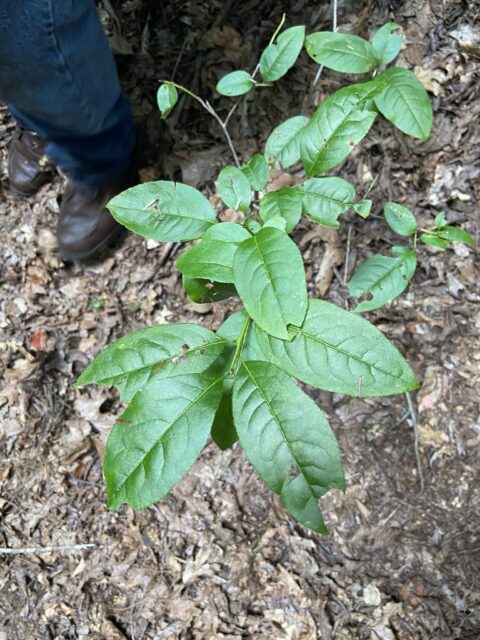
Sourwood leaves (cameo from Dr. Kilps’s boots)
Eastern Hemlock (Tsuga canadensis)
While the previous two trees prefer the drier tops of the sandstone hills, eastern hemlock can often be found in deep-cut valleys where the environment is cool and moist. The eastern hemlock is characterized by needles that appear white on the underside, connected to the twig by slender stalks, and leave a rough-surfaced twig when removed. Petrides describes this tree as “one of our most beautiful forest trees” due to its perfect brown cones and silvery foliage. The bark of the hemlock is dark brown and rough.
Although he considers it the most beautiful forest tree, Petrides confesses that is not the case when it comes to Christmas trees. When this tree dries up, all its little leaves fall to the ground. The wood of this tree is considered to have poor-quality wood and a stone-like hardness (so hard that it could chip a steel axe!) that helped it avoided harvest until the discovery that it’s pulp made effective railroad ties.
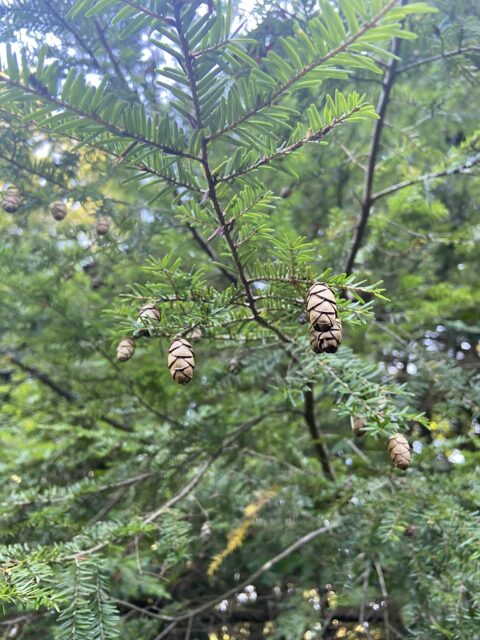
Eastern hemlock branch with visible cones
Sassafras (Sassafras albidum)
Although Forsyth did not mention this tree in her article, the Ohio Division of Natural Resources states that sassafras is native to all of Ohio, but is most frequently found in the southeastern portion, where the soils are acidic (ODNR)! This tree has three different patterns of leaves: 3 “fingers,” a “mitten and thumb, or a “smooth egg shape” arranged alternately along the twig (Petrides 137). When performing the very techincal “Scratch-and-Sniff” test on the bark of this tree, you’ll smell a spicy aroma.
The fragrant aroma and oils of this tree make it a suitable ingredient for teas or even soaps. The bark, with its red-brown color, can also be used as an orange dye for wool. The twigs are so delicious that even rabbits and deer will browse on their bark.
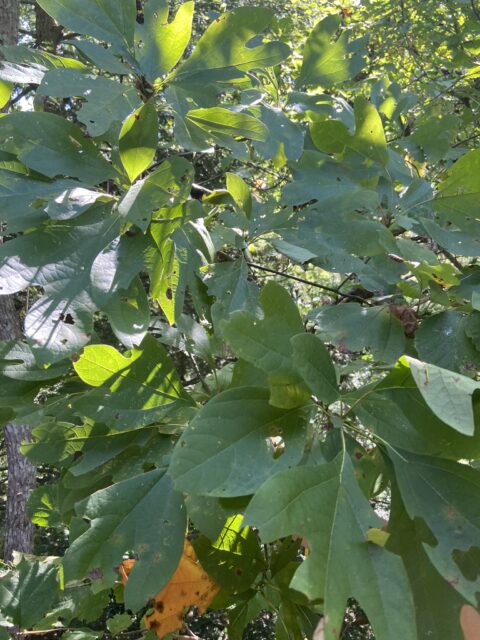
My best attempt to photograph the leaves on a sassafras that was just out of my reach. You can sort of make out a 3-fingered and egg-shaped leaf in the foliage
Biotic Threats to Forest Health
During our field trip, we discussed some tree species that face biotic threats that can impact the health of the entire forest ecosystem. These threats can cause a loss of biodiversity and impact the other plants and animals in the area. Below are two species and the threats they face that I found particularly interesting.
Butternut (Juglans cinerea):
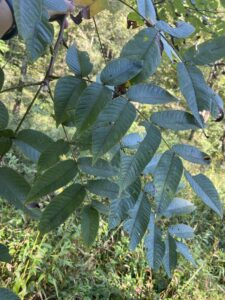
Butternut leaves from Deep Woods
This tree is a type of walnut tree sometimes called a white walnut. While several kinds of diseases and pests can affect the butternut, the worst and most prevalent threat affecting this beautiful tree is butternut canker disease. This diseases is caused by a fungus called Sirococcus clavigignenti-juglandacearum that has led to almost an 80% decrease in the butternut populations for some states (Purdue Extension). First reported in Wisconsin in the 60’s, researchers think this fungus likely came from outside the United States (Purdue Extension).
When infected, the tree’s main stem, base of tree, and roots develop cankers, or elongated sunken areas on the tree. As the disease continues to spread, the cankers amass together and eventually kill the tree by cutting off nutrient and water supply. Right now, there is no good cure for butternut canker. Some trees may be better able to resist succumbing to the disease if they are more established and mature, but it is generally fatal. The spores of the fungus are easily spread from rain and nearby water splashing the spores onto neighboring trees. Some ways to mitigate the spread are to cut off infected branches of the trees before it spreads to the main trunk. If you’d like to learn more about butternut canker disease, I found this information through the Purdue University Agricultural Extension fact sheet, here.
Eastern Hemlock (Tsuga canadensis):
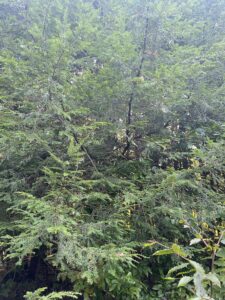
A group of eastern hemlock trees found at Deep Woods
Although white-wool like clusters under the branches may appear fungus-like, they are actually masses of egg sacs from the hemlock woolly adelgid (HWA), a small sap-sucking insect native to east Asia. The juvenile HWAs–often called crawlers–position themselves at the base of hemlock needles and suck the starches out of the plant using their piercing/sucking mouthparts. Although these bugs can live on any hemlock, eastern hemlocks are usually the ones to suffer fatalities from their damages (New York DEC).
After the crawlers suck the life force out of the hemlock trees by preventing nutrient flow, the needles of the tree fall off, leaving the canopy disrupted. Hemlocks stabilize soils, provide habitat for migrating birds, and create a dense canopy beneficial to lots of wildlife, so disrupting the hemlock’s role in the ecosystem is no joke. Current control includes the introduction of predators to the HWA, such as beetles that are natively found in the hemlock’s range. Some insecticides (Imidacloprid and Dinotefuran) have seemed to be effective when used in tandem to treat infected areas. Finally, agencies like the New York Department of Environmental Conservation (NYDEC), advise anyone to clean any gear that was near infested areas before locating to a new area. For more information on HWA and its effects on eastern hemlock, visit the NYDEC information site, which is where I gathered my information from.
Appalachian Gametophyte
Deep Woods was full of incredibly fascinating species, including the Appalachian gametophyte (Vittaria appalchiana). Despite looking moss-like, this plant is, in fact, a fern! What is so peculiar about this fern is that it only exists in the gametophyte stage of its life cycle! Most ferns have a small, inconspicuous gametophytes and exist primarily in their sporophyte form (the part of the plant we typically imagine when thinking of ferns)–but not the Appalachian gametophyte. Only two other species of ferns have never been documented in the mature sporophyte form (Pinson and Schuettpelz 2016).
Intrigued by the odd existence of this species, I did some digging in an excerpt from “Flora of West Virginia,” by P. D. Strausbaugh and Earl L. Core and the 2016 article, “Unraveling the Origin of the Appalachian Gametophyte,” by Pinson and Schuettpelz from the American Journal of Botany. Below is what I gathered from these readings.
What does a “normal” fern life cycle look like? Their life cycle consists of two alternating, free-living generations: the sporophyte and gametophyte phases. Typically, the fern sporophytes are the dominant phase of the life cycle, are diploid (2 sets of chromosomes), and are long lived. On the other hand, the gametophyte tends to be short-lived, haploid (1 set of chromosomes), and not able to reproduce vegetatively (with a few exceptions, of course). The Appalachian gametophyte just had to be different, and instead, it only exists in a vegetatively reproductive gametophyte form! Although part of a tropical lineage of ferns, this temperate species is found in the Appalachian Mountains and Plateau in the eastern US. It tends to grow on rock outcrops near water–much like the cave we saw it in at Deep Woods.
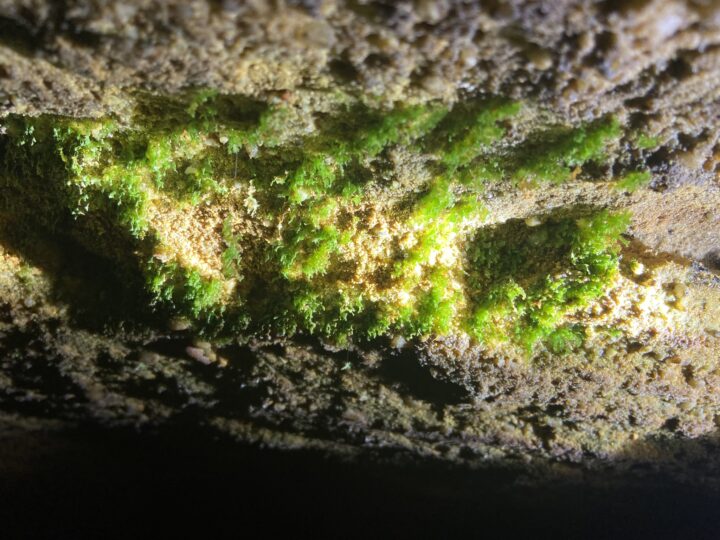
Appalachian gametophyte in a cave at Deep Woods
Since the the Appalachian gametophyte doesn’t produce spores from a sporophyte, how does it reproduce? This plant reproduces asexually from structures called gemmae that form on the edges of the gametophyte and separate from the plant once mature. Once separated, the gemmae disperse (not very far) and grow into their own clone of the gametophyte it just left. Compared to the typical spores of a fern, gemmae are relatively large and ill-equipped for long-distance dispersal. Some suggestions on dispersal methods include wind, water, or animals. Kimmer and Young (1995) found evidence of slug-facilitated dispersal in bryophytes which supports the hypotheses for animal-facilitated dispersal of the Appalachian gametophyte.
More evidence for limited-dispersal of the the Appalachian gametophyte presents itself in the complete absence of the species north of the glacial boundary, despite showing evidence that they should be able to survive there (Stevens and Emery 2015). Additionally, substrates that could support the plant within its range (e.g., road cuts, tunnels, and other substrates), remain uncolonized. These strange aspects of the gametophyte’s range suggests that the original spore distribution must have occurred from a fully-functional sporophyte. Based on where the range of this species stops in New York, the likely time frame in which the Appalachian gametophyte lost its ability to produce this functional sporophyte must have occurred pre- or mid-ice age (the last one).
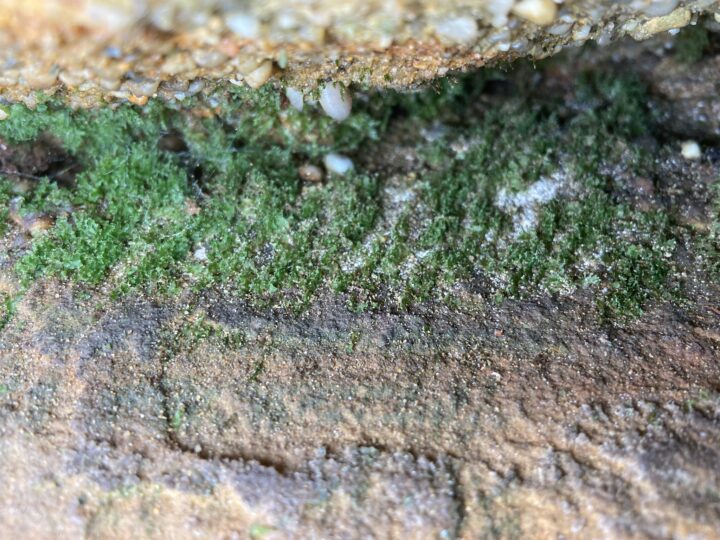
Another look at the Appalachian gametophyte
With such as restrictive method of dispersal and reproduction, could the current populations of the Appalachian gametophyte be being sustained by long-distance dispersal from some tropical sporophyte source? Based on allozyme studies presented in the Pinson and Schuettpelz article, I don’t think that a tropical sporophyte source is sustaining the gametophyte population. The species is essentially isolated in terms of reproduction (from number of chromosomes). Additionally, the range of the gametophyte cuts off in the southern area of New York, further supporting that there isn’t an “outside” source of propagation. Rather, the wide range of the Appalachian gametophyte would be due to spore dispersal until the sporophyte went extinct. The dispersal from the tropics must have been a one-time thing–a one-way ticket to a North American climate that may have been closer to the tropic conditions before the most recent ice age cooled it closer to the climate we know today. If this interested you too, here is the link to the article where I found the information.
Scavenger Hunt: Find Two Lichen Species
Once again, I was given a top-secret mission on this field trip. This time: find two species of lichen. Wait…hold up? Lichens aren’t plants though, and I though I was trying to understand the plants of Ohio. Neither plant, nor animal, lichens are a unique example of symbiosis in the natural world. The two partners in the symbiosis are algae (or cyanobacteria) and fungus! Like plants, they are photosynthetic! They are also often found using trees as a substrate, protecting them from the dangerous outside hazards. Plus, they’re living among the plants and animals, so they must be pretty cool…correctamundo! Here are some neat species of lichens we discovered at Deep Woods…I may have gone a bit overboard 🙂
Dixie Reindeer Lichen (Cladonia subtenuis)

Gray reindeer lichen at Deep Woods
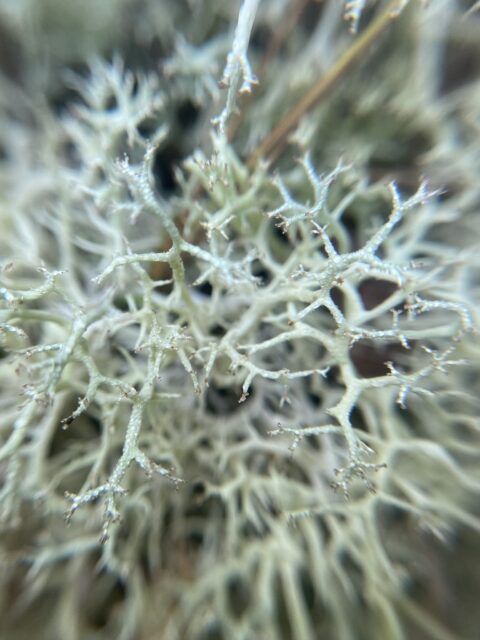
Gray reindeer lichen up close
Many-Forked Cladonia (Cladonia furcata)
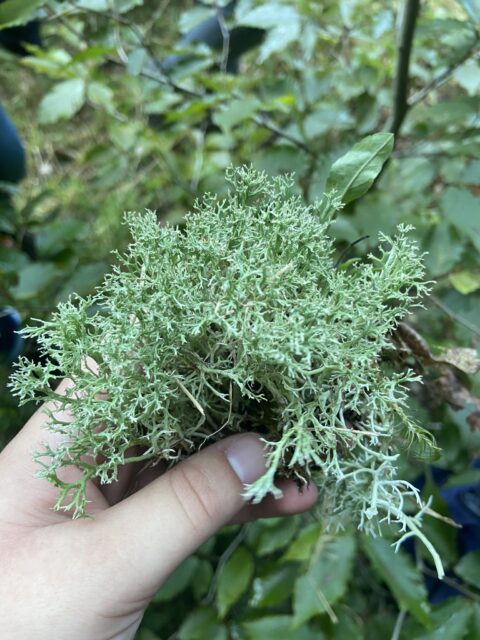
A chunk of many-forked cladonia
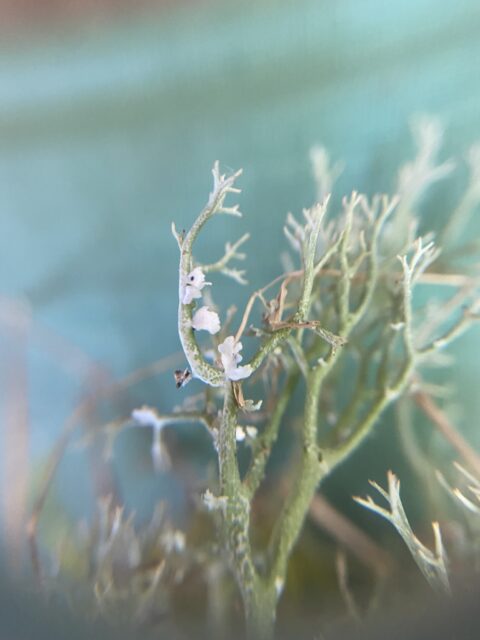
Spot the scales? This is the only species of reindeer lichen in Ohio with those scales.
Common Powderhorn (Cladonia coniocraea)

Common powderhorn
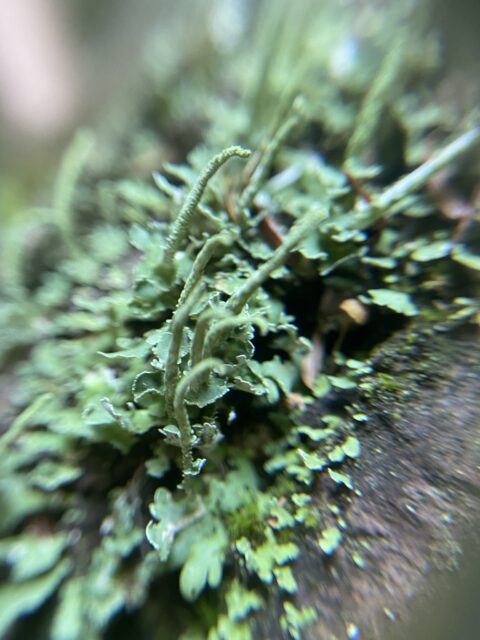
Closeup of the “horn” structure
Common Greenshield Lichen (Flavoparmelia caperata)

Common greenshield lichen on a tree trunk
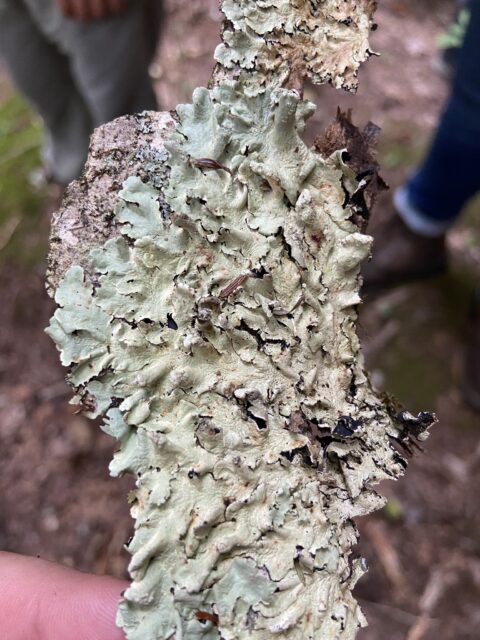
Common greenshield found on fallen bark
Other Neat Findings
While I wish I could share every photo, every plants, every neat fact I learned on this field trip, we simply don’t have the room or time. Instead, I’d like to share with you just a few of the other neat things we found at Deep Woods–from non-vascular plants, to parasitic plants, to plants that just smell good. It was very hard to choose what to share.
Pincushion Moss (Leucombryum glaucum)
this moss is a nonvascular plant that form dome shape cushions on the ground all. A great hiding place for insects, many animals will overturn the masses of pinchushion moss in their attempts to find food (some common perpetrators include crows, squirrels, and chipmunks. However, some insects avoid this moss because of a toxin it secretes, making it a possible area of study for new insecticides (Illinois Wildflowers).
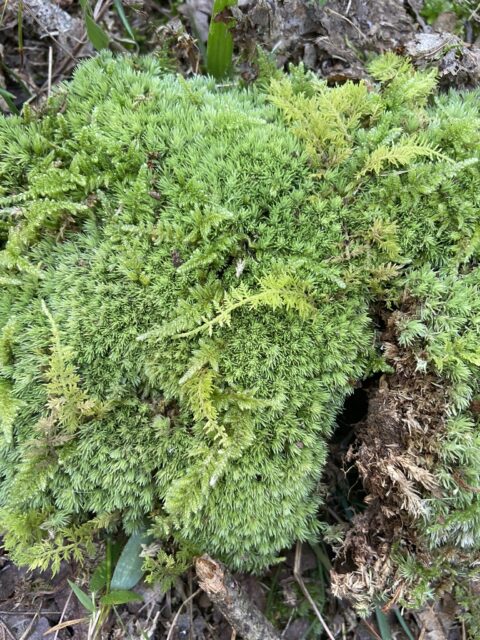
A cushion of pincushion moss!
Spinulose Wood Fern (Dryopeteris carthusiana)
Moving on to vascular plants without seeds, we have an example of one of the many ferns we saw: Spinulose wood fern. The fronds of the fern are thrice-divided, and the basal leaves lack spores compared to the leaves towards the terminal end of the fronds. The sori, or groups of spores, are found on the undersides of the leaves in circles arranged in rows along the midvein (Minnesota Wildflowers).
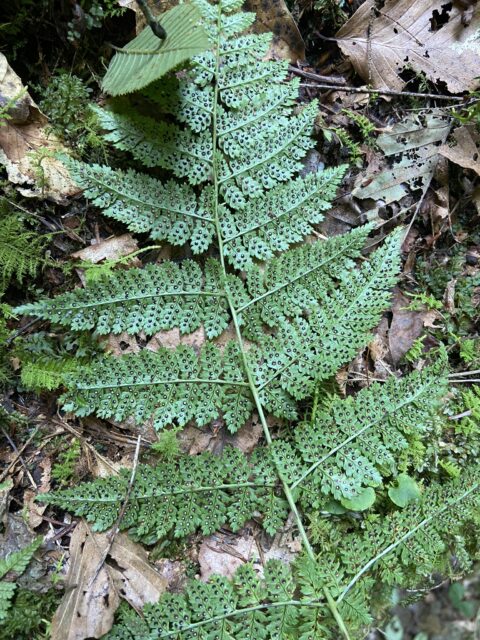
The underside of a spinulose wood fern. Look at those groups of spores!
Pinesap (Monotropa hypopitys)
This plant is pretty special because it is parasitic! The plant is characterized by its pale red flowers and aromatic scent. Not a single part of pinesap is green because it doesn’t contain any chlorophyl. This means that the pinesap must gain its nutrients from other organisms, such as fungi or other plants. Bumble bees are important cross-pollinators of the plants, visiting the flowers for their delectable pollen and nectar. (Illinois Wildflowers)
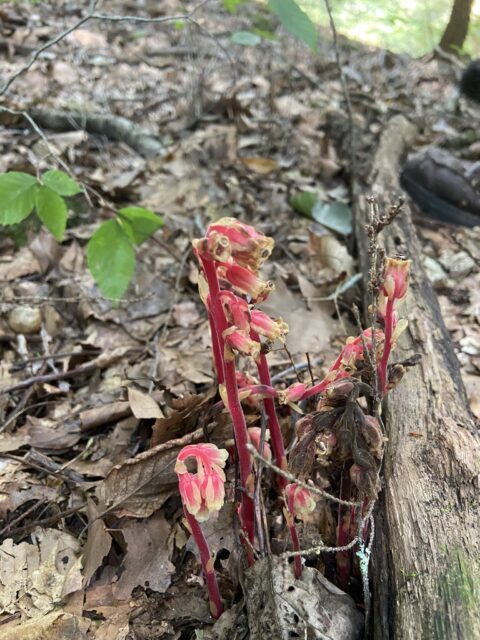
Notice the contrast of the red color from the pinesap against the brown leaf litter. The flowers can range from a pale yellow/brown to red
Black Birch (Betula lenta)
A tree with brown-black bark and serrated leaves, this tree may look “normal,” it smells amazing. When performing a scratch-and-sniff test on the bark of these twigs, you’ll notice a fragrant, wintergreen aroma. Wintergreen oils are usually derived from the sap and leaves of the tree. This tree is sometimes referred to as sweet birch or cherry birch. (Petrides 313)
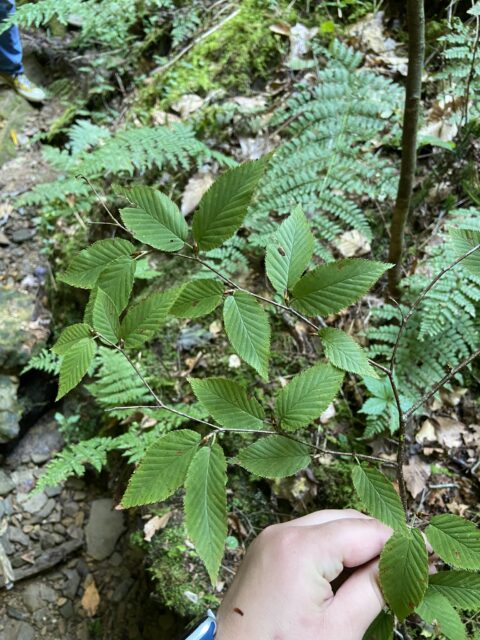
A black birch branch–If only you could smell photos!
